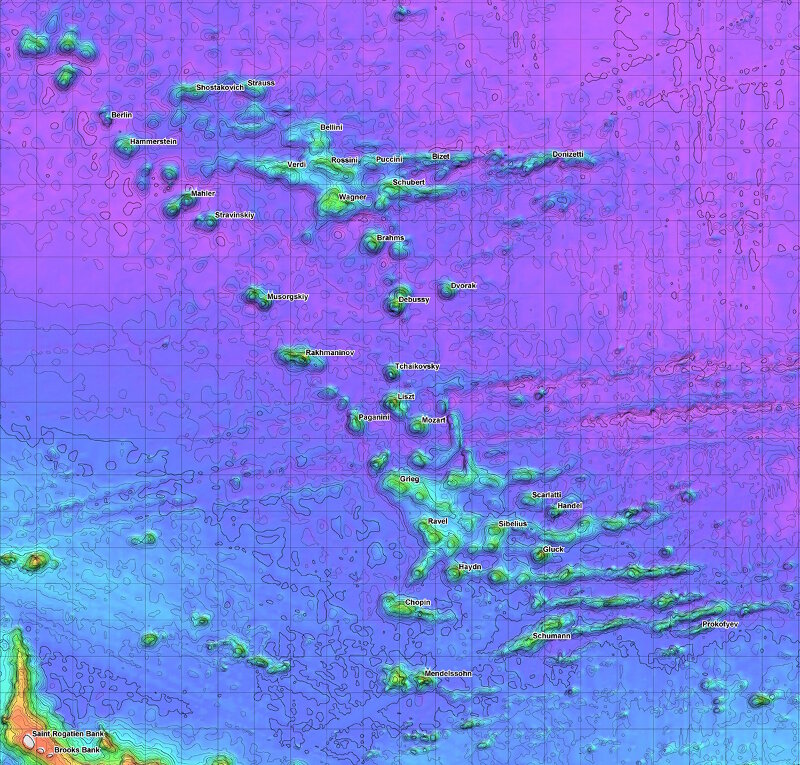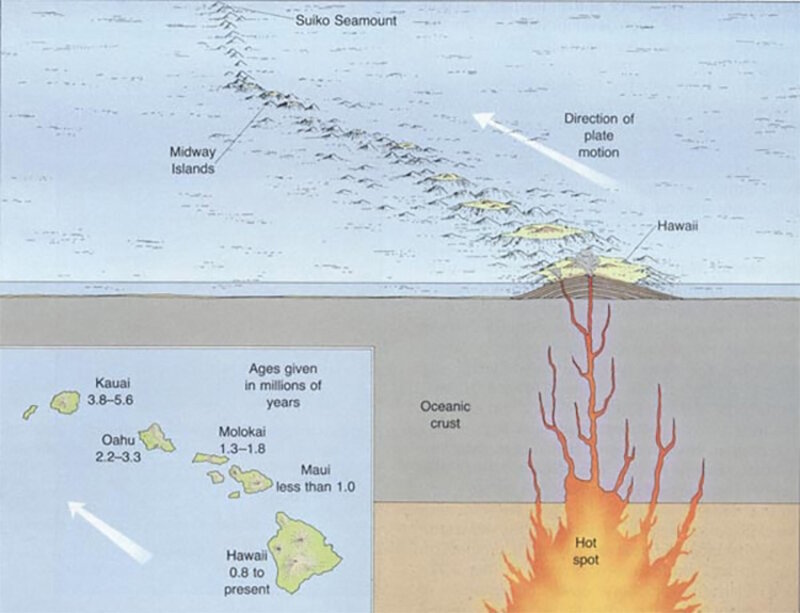
By John R. Smith - University of Hawaii at Manoa

Map detailing the names of the seamounts within the Musicians Seamounts group. Image courtesy of Seamount Biogeosciences Network - Seamount Catalog. Download larger version (jpg, 1.7 MB).
The Musicians Seamounts are a province, or collection, of about 25 underwater mountains in the central Pacific Ocean just north of the main Hawaiian Islands and bordering the eastern boundary of the Papahānaumokuākea Marine National Monument. They are extrusive constructional volcanic features, meaning they were erupted as molten lava from the seafloor and built up over millions of years. Some may have eventually broken the sea surface and become islands, while most never made it that far, stalling out before reaching their first breath of air.
During the latter half of the previous century, rocks from some of these seamounts were dredged up and dated, indicating these features are of Cretaceous age, 65 to 95 millions old, mere youngsters during the time that dinosaurs ruled the Earth. As far as we know, the Musicians Seamounts volcanoes are all now extinct, much like their dinosaur contemporaries.

The best example of a hotspot producing a line of volcanic islands is the Hawaiian hotspot. This drawing, from Thurman’s Introduction to Oceanography, illustrates how the Hawaiian chain formed as the Pacific tectonic plate moved over the hotspot. Image courtesy of Hawaii Undersea Research Laboratory. Download larger version (jpg, 171 KB).
There have been several theories as to the exact origin of the Musicians, although all agree they are volcanic seamounts and a hot spot plume was involved — mimicking the method of formation of the neighboring Hawaiian chain, which is the classic hot spot plume model most often studied and referred to in this field of research. Complications to this model of formation in the case of the Musicians and associated ridge structures include interaction of the hot spot with an ocean ridge spreading center or its remnant fracture zone ridges, or even from simple cracking and subsequent "leaking" of the oceanic, or tectonic, plate comprising the seafloor.
When the Musicians Seamounts are mentioned in discussions with people of diverse backgrounds, one of the first questions is how did they get their name and why name them after composers, especially with some of them being classical musicians from hundreds of years ago who had nothing to do with their discovery? Well, one must put themselves in the perspective of marine scientists and surveyors 50 to 60 years or more ago to gain that answer.
Early sonar systems came into widespread use around the time of World War II, and the war in the Pacific greatly increased the presence of ships crossing remote areas of this vast ocean, doing depth soundings as they transited and surveyed for new bases of operation in strategic locations. After World War II came the dawn of modern oceanography and further work was carried out in the Pacific, with more of a research focus, although there were still defense interests because of the Cold War era that persisted for decades until the early 1990s.
As a result, hundreds and then thousands of seamounts in the Pacific have since been mapped to various levels of detail. You can imagine the overwhelming task of finding appropriate names for these numerous features! Hence, perhaps explorers were looking for an easy way to name collections of geographically grouped seamounts and pay homage to well deserving individuals at the same time.

Dr. Henry William Menard, Director of the U.S. Geological Survey from 1978 - 1981. He was credited with naming the Musicians Seamounts group in 1959. Image courtesy of the U.S. Geological Survey. Download image (jpg, 17 KB).
The Musicians Seamounts group was given that name in 1959 by Dr. H. W. Menard, a renowned marine geologist at Scripps Institution of Oceanography. The individual features are names for famous composers such as Mendelssohn, Tchaikovsky, Gershwin, Beethoven, Verdi, and more. Many of the seamounts within that group were named by David Rea and Fred Naugler of the U.S. Coast and Geodetic Survey, the predecessor agency to the National Oceanic and Atmospheric Association (NOAA), following a dedicated series of expeditions to the Musicians and other areas in the north central Pacific and U.S. West Coast. This focused effort, called the Scientific Exploration and Mapping Program (SEAMAP), took place from 1960-1973 with the goals of systematically mapping the seafloor and collecting oceanographic data from these regions.
So what other groups have been so honored you may ask? Professor Menard and his associates went on to name the Mathematician and Mapmaker Seamount groups in 1960. Additional seamount groups named by others include the Geologist Seamounts southwest of Hawai‘i and the U.S. Coast and Geodectic Survey Seamount Province off Alaska.
It is indeed curious that just to the north of Hawai‘i lie these little known musical mountains that have largely been left alone, to sing themselves to sleep in the murky deep. Until now...